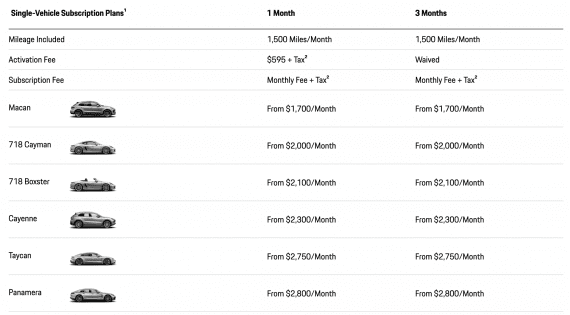Automobile sales are changing. Drivers can now subscribe online to vehicles, swapping their rides as frequently as once a month. Could it change how consumers feel about ecommerce and subscriptions in general?
For example, Porsche Drive is a new subscription program in the United States and Europe. A shopper can “subscribe” to a single vehicle, such as a 718 Boxster convertible, a more family-friendly Cayenne, or several other cars.
The program is all-inclusive — the fee includes insurance, roadside assistance, vehicle maintenance, and concierge service — and is one of many similar automobile subscriptions that are consummated online, more flexible and convenient than traditional leases.

The Porsche Drive subscription program is one example of automobile manufacturers using subscriptions to finance vehicles. Click image to enlarge.
Vehicle Ecommerce
Vehicle subscriptions are part of the automotive industry’s migration toward ecommerce.
“The future of automotive retail will be digital and direct to consumer,” according to a March 2023 report from McKinsey & Company. “Today, fewer than 3 percent of customers [in Europe] say they purchase vehicles fully online, but 29 percent indicate that they want to buy their next car entirely online. An additional 23 percent say they would like to order online but require some physical touchpoints (for example, a test drive) along the purchasing journey.”
The McKinsey & Company article focused on European automobile sales, which are more ecommerce centric than in the United States. But the trend could spread globally.
While most wanted to purchase or lease a vehicle in the familiar in-person manner, some 33% of surveyed buyers were interested in vehicle subscriptions, and 15% were “very interested,” according to McKinsey & Company.
Impact
Those findings surprise me. Automobile subscriptions, like leases, are a form of financing. The fact that one in three surveyed buyers was interested in subscribing might indicate wanting a better car sooner.
Or it could foretell a change in how shoppers feel about subscriptions overall.
The subscription model has been successfully deployed across entertainment (Netflix, Spotify), software (Adobe Creative Cloud, Microsoft Office 365), and even everyday items (Amazon’s Subscribe and Save).
Automotive subscriptions could inspire more sectors to do the same.
More subscription options. As consumers become comfortable with subscription-based services for even big-ticket items, more industries could offer similar models, where customers pay online for extended access to goods or services rather than a one-time purchase.
Customer retention. Successful subscription businesses retain subscribers. Thus a shift to ecommerce subscriptions could improve customer service, product quality, and overall customer experience.
Service focus. A migration to subscriptions could lead to a greater emphasis on providing value through personalized recommendations, premium support, and exclusive access to events or content.
Secondary markets. Subscriptions to physical goods could spur sales of second-hand items. For example, a clothing subscription service will eventually sell garments outright.
Data collection. With a subscription model, ecommerce businesses can gather relatively more data on customer preferences, usage patterns, and behavior. This first-party info could lead to increased personalization, with companies using data to tailor product offerings, marketing campaigns, and customer service to individual needs.
New buying habits. If they become accustomed to subscriptions, shoppers’ collective purchasing behavior may change. They might prioritize the value and convenience of a subscription over the benefits of owning a product.





